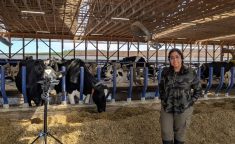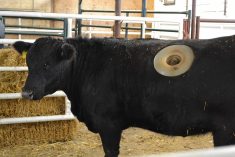This may be a year to consider chickpeas and fababeans, according to Hugh Campbell of Terramax and Scott Preston of Saskcan, a subsidiary of Alliance Grain Traders.
The two were in Lethbridge recently to promote those crops to southern Alberta farmers.
“Chickpeas are a staple in North Africa, and fababeans are very popular in Arab countries, especially Egypt,” said Campbell. “In this country, low-tannin fababeans are a great substitute for feed peas in hog, poultry and dairy rations.”
Major growing areas for chickpeas have had problems this year, said Preston. Mexico has had frost, Australia’s floods damaged its chickpea-growing areas, and India has had short crops that have led to export controls on desi chickpeas.
Read Also

Moo translator and methane measures: There’s an app for that
Dalhousie University researchers use artificial intelligence to create new dairy farm apps that analyze cattle sounds and measure methane.
Those production problems are creating opportunities in Egypt, Jordan, and other parts of North Africa and the Middle East, said Preston.
“We expect our Middle Eastern markets to hold up as long as the economy improves,” said Preston. “People there had to reduce their consumption of chickpeas and beans in 2008 because of the economy. Now, the merchants tell us it’s business as usual.”
Fababeans are also tempting from a production viewpoint.
“Under irrigation, fababeans give phenomenal yields, 80 to 100 bushels an acre,” said Campbell. “And, they are very high nitrogen fixers. They leave at least a pound of nitrogen for every bushel of yield.”
However, fababeans need more moisture than is usually available on dryland farms in southern Alberta. Campbell said disease has never been a problem on fababean crops he has seen, but grasshopper and lygus bug infestations can be. Some fababeans near Lethbridge were a favourite with pea leaf weevils last year. The leaves appeared serrated from the insects’ feeding.
Seed early
Fababeans need a fairly long season, so very early seeding is recommended – at least as early as peas and on cereal stubble to avoid diseases of other broadleaf crops. One of fababean’s biggest advantages is that it’s very cold hardy. Even with a killing frost, Campbell says, fababeans will come back from underground nodes.
Alberta Agriculture pulse specialist Mark Olson agrees with Campbell that fababeans are relatively easy to grow.
“The only problem with them is the marketing,” he said. “Egyptians like the bitter taste of a tannin type for falafel and breads. But for feed you need a low-tannin type.”
Campbell is also recommending B90 (formerly registered as Amit) kabuli chickpeas, a variety that’s smaller than most kabulis and has some asochyta resistance.
“It soaks up to a size that’s particularly desirable on the international market,” he said. “Being smaller, it cooks in half the time, using half the fuel of larger varieties. That’s important in some markets. It’s also sweeter tasting and stays bright and shiny when it’s canned.”
Preston said Alliance Grain Traders is giving growers access to many new markets for pulses. The company was founded and is run by the Al-Katib brothers, Omer and Murad, who were born in Davidson, Saskatchewan, but maintained their family links to the Mediterranean region. They use their old-world connections in their marketing, but they have also acquired facilities around the world. They are now the world’s largest pulse traders, and export to every region of the world. In Alberta, Alliance has a facility at Gibbons and is considering locating a plant in southern Alberta.
———
“Underirrigation,fababeansgivephenomenalyields,80to100bushelsanacre.”
HUGH CAMPBELL














